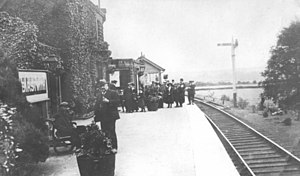Birstwith railway station served the village of Birstwith, North Yorkshire, England from 1862 to 1964 on the Nidd Valley Railway.
Birstwith | |
|---|---|
 Birstwith Station about 1911 | |
| General information | |
| Location | Birstwith, North Yorkshire England |
| Coordinates | 54°02′01″N 1°37′36″W / 54.0337°N 1.6267°W |
| Grid reference | SE245598 |
| Platforms | 1 |
| Other information | |
| Status | Disused |
| History | |
| Original company | North Eastern Railway |
| Pre-grouping | North Eastern Railway |
| Post-grouping | London and North Eastern Railway |
| Key dates | |
| 1 May 1862 | Opened |
| 2 April 1951[1] | Closed to passengers |
| 31 October 1964[2] | Closed to freight |
History
editThe station opened on 1 May 1862 by the North Eastern Railway.[3] One of the two important intermediate stations on the Nidd Valley Branch, (the other being Dacre), it had a three-storey station building with the platform at first floor level, with access by steps from the yard. This was a stone building to the designs of NER Architect Thomas Prosser, and with its stepped gables it resembled those at Ripley, Dacre and Pateley Bridge. There was a large goods yard with 6 coal cells, a warehouse, a hand crane, a weigh office and five cottages for railway staff on the northern boundary. The signal and point levers were originally located on the platform but in April 1910 a new signal cabin was put into use at the Ripley end of the platform. Although there was a loop off the single line at Birstwith (and at Dacre), this could only be used by freight trains - in fact the timetable did not require passenger trains to cross at intermediate stations.
Birstwith handled large volumes of grain for Wreaks Mill (later Woods Flour Mill) although this had to be transported by road for the last few hundred yards as the mill was on the opposite side of the River Nidd. As a result the goods facilities remained open after withdrawal of the passenger service from 2 April 1951, finally closing on 31 October 1964. The site was completely cleared and redeveloped after closure, and one of the only remaining traces is the western abutment of the bridge over the road leading to Clint, and the name of the Station Hotel opposite the former yard entrance.
References
edit- ^ Hoole, K (1985). Railway Stations of the North East. Newton Abbott: David & Charles. p. 154. ISBN 0715385275
- ^ Hoole, K (1985). Railway Stations of the North East. Newton Abbott: David & Charles. p. 154. ISBN 0715385275
- ^ M E Quick, Railway Passenger Stations in England Scotland and Wales—A Chronology, The Railway and Canal Historical Society, 2002, p. 75
External links
edit| Preceding station | Disused railways | Following station | ||
|---|---|---|---|---|
| Darley Line and station closed |
Nidd Valley Railway | Hampsthwaite Line and station closed |